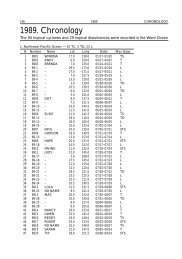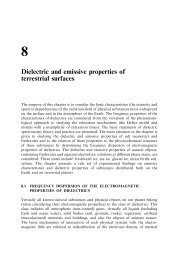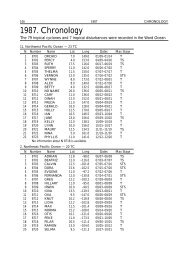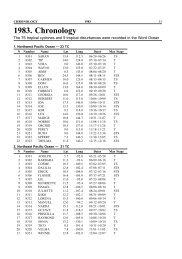Dear Dr. Pu, Thank you for your letter. Sorry for delay of my reply: I ...
Dear Dr. Pu, Thank you for your letter. Sorry for delay of my reply: I ...
Dear Dr. Pu, Thank you for your letter. Sorry for delay of my reply: I ...
You also want an ePaper? Increase the reach of your titles
YUMPU automatically turns print PDFs into web optimized ePapers that Google loves.
3. Is the high geoeffectiveness "overestimated" or "incorrect"?<br />
As shown in Reviewer #2's first and second reports, it is the different definitions <strong>of</strong> "halo" CMEs<br />
used by Kim et al. and Gopalswa<strong>my</strong> et al. that make the significant difference <strong>of</strong><br />
geoeffectiveness. In Gopalswa<strong>my</strong> et al.' paper, "halo" CMEs are defined as the CMEs with<br />
apparent angular width <strong>of</strong> 360 degrees, i.e., FULL halo CMEs; and in Kim et al., "halo" CMEs<br />
are<br />
defined as the CMEs with apparent angular width greater than 120 degrees, i.e., "FULL +<br />
PARTIAL" halo CMEs.<br />
Because most <strong>of</strong> frontside PARTIAL halo CMEs could not encounter<br />
the Earth, it is understandable why Gopalswa<strong>my</strong> et al.' geoeffectiveness is significantly higher<br />
than Kim et al.'. Actually, using the data in Gopalswa<strong>my</strong> et al' paper, the low geoeffectiveness<br />
can also be obtained if using the same definition <strong>of</strong> halo CMEs as used by Kim et al., as shown<br />
in Reviewer #2's first report.<br />
In summary, both the selection method <strong>of</strong> frontside halo CMEs<br />
and the high geoeffectiveness in Gopalswa<strong>my</strong> et al.' paper is reasonable, and acceptable. The<br />
arguments and conclusions in the comment paper are incorrect.<br />
Reviewer #3 (Comments):<br />
The comment on Gopalswa<strong>my</strong> et al.'s higher rate <strong>of</strong> geoeffective<br />
front-side full-halo CMEs made by Yermolaev, to <strong>my</strong> opinion, is<br />
not valid. In Yermolaev's comment, he/she criticizes that<br />
Gopalswa<strong>my</strong> et al. use harder/illogical criteria to filter<br />
front-side CMEs, which leads those front-side CMEs without<br />
disk activities missed and there<strong>for</strong> yields false high rate.<br />
The critic doesn't realize that the high rate is due to the<br />
stricter selection <strong>of</strong> halo CMEs, not the stricter selection<br />
<strong>of</strong> front-side CMEs. In different studies, different<br />
definitions <strong>of</strong> halo CMEs are used. For example, halo CMEs<br />
actually mean those CMEs with angular with larger than 140,<br />
130, or 120 degrees in many studies, such as by Kim et al.<br />
(2005), Wang et al. (2002), Webb et al. (2000), and St. Cyr et al.<br />
(2000). Different definitions will cause different preselected<br />
sample. In Gopalswa<strong>my</strong> et al.'s paper, only FULL halo CMEs are<br />
considered, that results in 378 events (note this number is <strong>for</strong><br />
all halo CMEs no matter where did they come from) from 1996 to<br />
2005. We can make a comparison <strong>of</strong> this number with the number, 883,<br />
from Kim et al.'s paper. It's obvious that the number by<br />
Gopalswa<strong>my</strong> et al. is 42.8% <strong>of</strong> that by Kim et al. even though<br />
the statistical period in Gopalswa<strong>my</strong> et al.'s paper is more<br />
than two-year longer than that in Kim et al.'s paper. It's<br />
generally accepted that the wider the CME angular width is,<br />
the higher probable is the CME to encounter the Earth and cause<br />
geoeffectiveness. It is because a wider angular width means<br />
that either the location <strong>of</strong> a CME is closer to the center <strong>of</strong><br />
solar disk, where the CME right faces to the Earth, or the

















